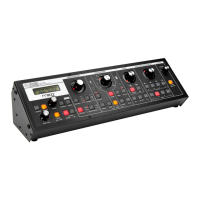Page20
SlimPhattyUser’sManualTheComponents
Page21
SlimPhattyUser’sManualTheComponents
F. Input/Output Panel
The Back Panel provides all of the input and output connections. In addition to Audio Input/Output jacks,
there are CV and Gate inputs, connections for MIDI, and the power connector and power switch.
Power Connector:
This is a standard AC power inlet, Use only a power cord designed to mate with this receptacle. The Little
Phatty’s built-in universal power supply is designed to work with power inputs of 90-250 Volts AC, 50/60 Hz.
IMPORTANTSAFETYNOTE–Donotalterthepowerconnectorinanyway.Doingsocan
resultintheriskofshock,injuryordeath.Befamiliarwiththesafetyinstructionsprintedatthe
beginningofthismanual.Iftheconnectorisdamaged,referservicingtoqualiedpersonnelonly.
Audio IN:
The Audio In jack allows an external audio source to be mixed with the SP’s VCOs, and then routed to the
filter for processing. The SP has no provisions for adjusting the level of this input, it must be controlled ex-
ternally. The audio input is designed to distort as the level of the external audio gets very high, adding color
to the sound.
Audio OUT:
The Audio Out jack provides an unbalanced line-level signal for connecting to an amplifier or mixer.
CV Inputs:
The Pitch, Filter and Vol (Volume) CV jacks supply power and will accept an expression pedal such as the
Moogerfooger EP-2 (ring = +5.5 supply to the pedal, tip = variable CV return), or a control voltage from
–5 to +5 Volts. The KB Gate Input accepts a footswitch (a momentary, normally-closed footswitch like the
Moog FS-1) or a +5 Volt Gate Signal.
MIDI Connectors (DIN and USB):
These are DIN connections for MIDI In/Out/Thru, and MIDI USB connector. MIDI I/O is configurable for
either connection type. For more information on configuring MIDI, see page 32.
PERFORMANCETIPS:
1.YoucanusetheSPtoprocessanyaudiosignalsimplybypluggingintotheAudioINjack.
Toheartheexternalaudiosignalwithouthavingtoholddownakeyonthekeyboard,pluga
dummyplug(orapatchcordwithnothingconnectedtotheotherend)intotheKBGatejack.
Thiswillleavethekeyboardgateopen,andthevolumeenvelopewillremainatitsSustain
leveluntilthekeyboardgatecloses.Duetothedesignoftheenvelopecircuits,youwillneedto
turntheenvelopeDecayparameterdownbelow12:00inorderfortheSustainleveltoremain
constant.Ifyounoticethatthevolumeoftheexternalsignalbeginstoslowlyfadeaway,check
tobesuretheenvelopeDecayparametersarenotsettoohigh.
2.TheSP’sAudioInputisnotlimitedtoprocessingmonophonicsignalsitcanworkwellfor
processingpolyphonicsignals,too.Forexample,connecttheMIDIOutoftheSPtotheMIDI
Inputofanotherpolyphonickeyboard,thenfeedthataudiooutputbackintotheSPthroughthe
AudioInjack.NowyouhaveaPOLYPHONICsourcethatisbeingaffectedbytheSP’sFilter,
OverloadandEGRcircuits.

